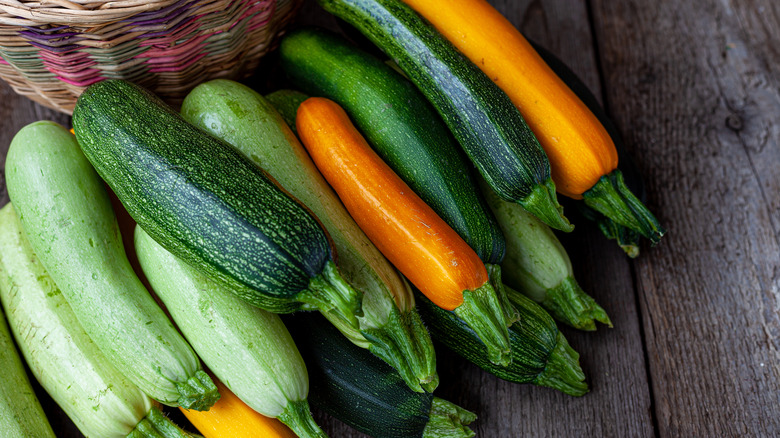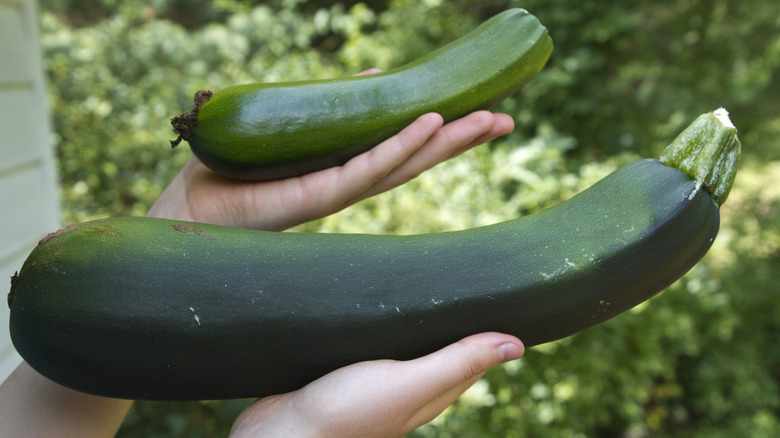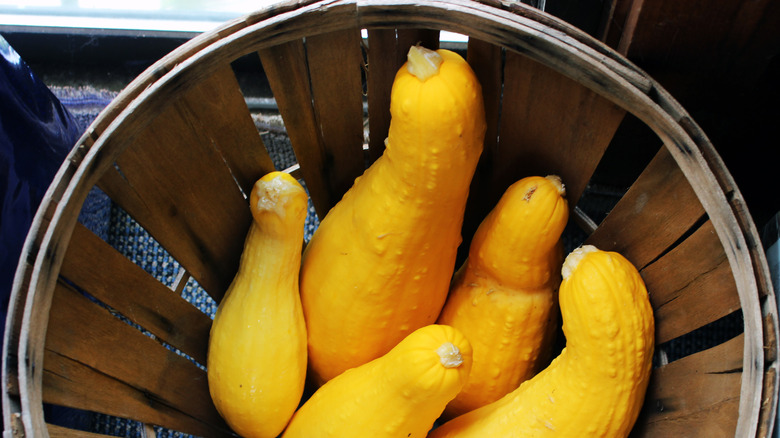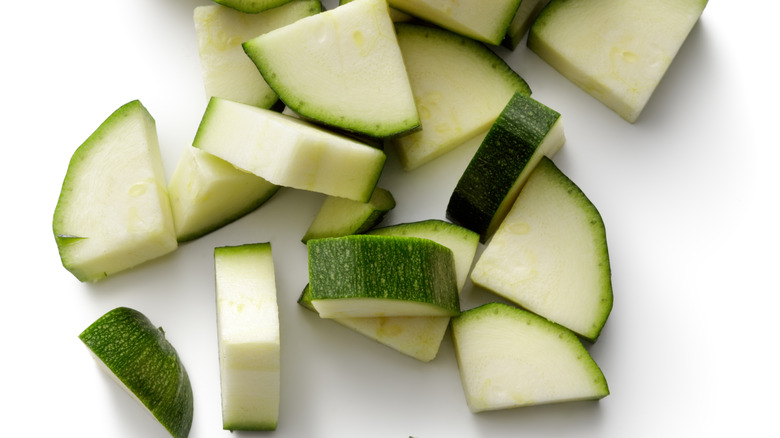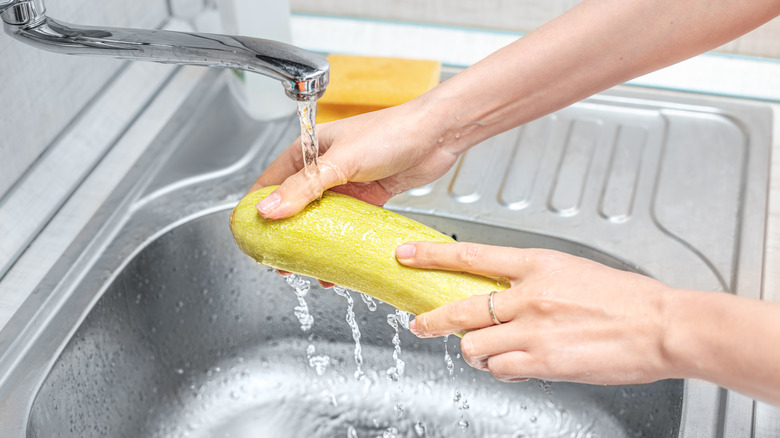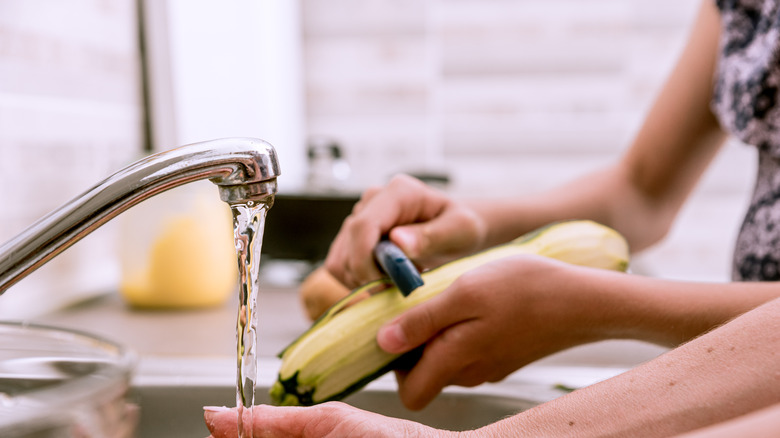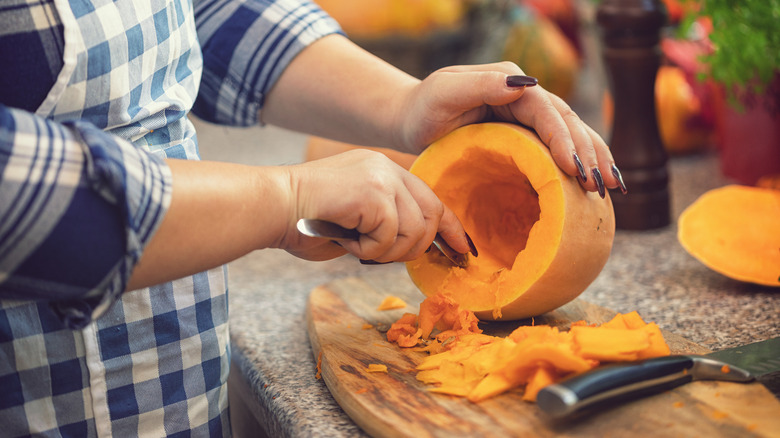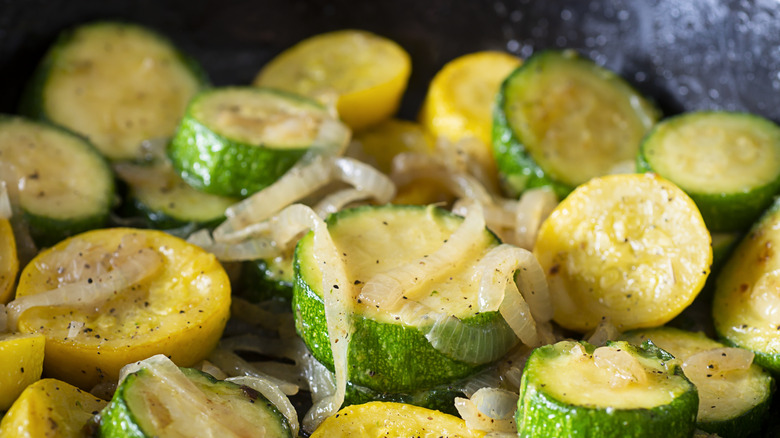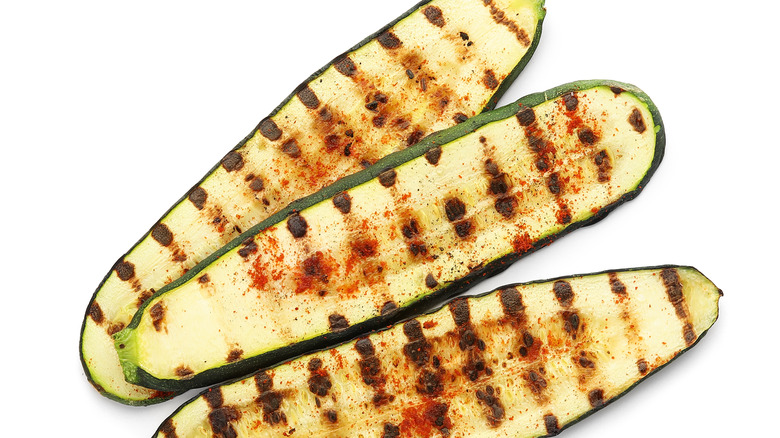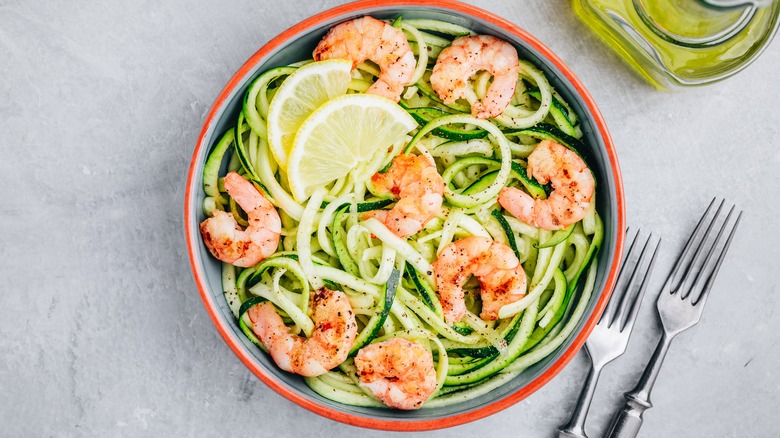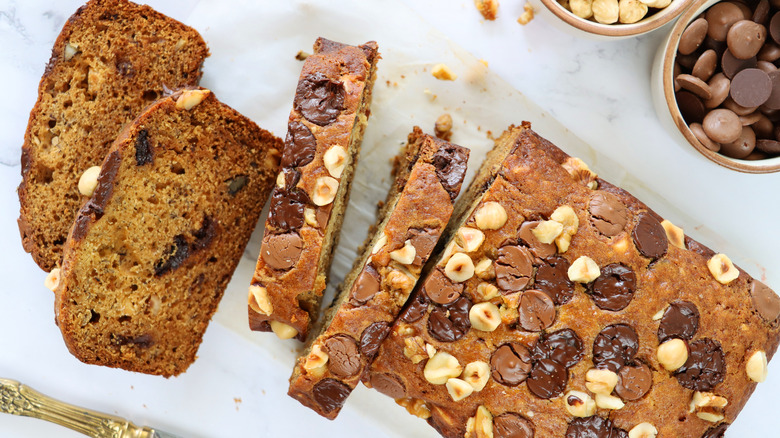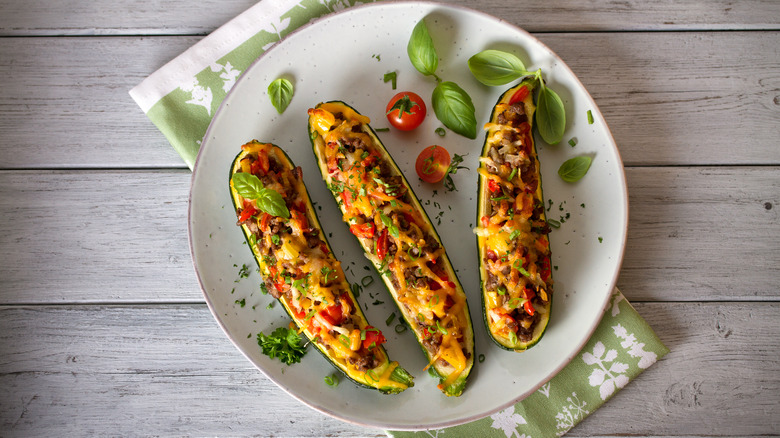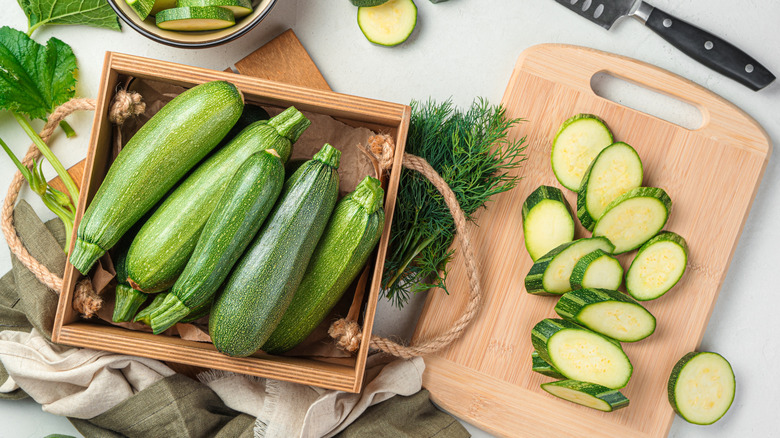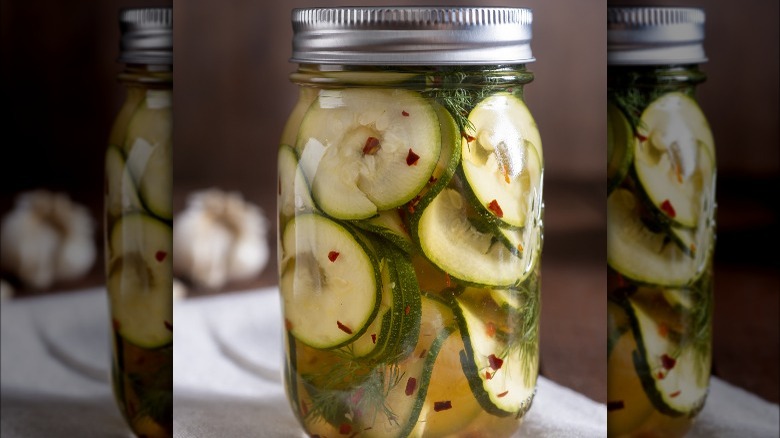14 Mistakes You Might Be Making With Summer Squash
There are many different varieties of summer squash to choose from, including the more well-known zucchini and yellow squash, as well as the lesser-known zephyr squash and eight ball zucchini. Whether you grow your own summer squash, or like to pick some up at the farmers market or grocery store, you know how good it can taste and how much it can add to a meal. But you might be making some mistakes with your squash that could be negatively impacting your meals.
There are actually several mistakes people make when it comes to picking out the right summer squash, storing it, cooking it, and saving the leftovers. You'll want to avoid these mistakes at all costs to make sure that your squash stays fresh, tastes amazing, and adds the perfect complement to your meal. Read on to how to avert a disaster the next time you plan to make summer squash.
1. Choosing the biggest squash
Bigger squash equals better squash, right? After all, you're getting more squash to use in your favorite recipes. If you've been following this approach when choosing squash at the grocery store or farmers market (or even picking your own from your garden), you've been making a mistake. Contrary to what many believe, smaller squash are actually better than their bigger counterparts.
Younger and less mature squash — and therefore smaller squash — will have the best flavor. These are going to be the most tender. Conversely, if the squash is allowed to grow too long, it can taste bitter and have a more fibrous texture. Overly large squash can also be too watery, which can impact how well they'll cook in your recipes.
In addition to being smaller, the best summer squash should also feel heavy for its size. They should feel rather firm, and should not have a lot of give when you press gently on them. The outer skin should look bright and shiny.
2. Not storing the squash properly
Once you bring your squash home from the grocery store, it is important to make sure that you store it properly. Improper storage can have a negative impact on the way the squash tastes, or can even cause it to spoil. One of the biggest mistakes people make when storing zucchini and other summer squash varieties is washing them first. Doing so is not recommended, as it can make the squash too moist, causing it to go bad more quickly.
Rather, when you unpack your grocery bags, place your squash into a perforated plastic bag with a paper towel inside. This will help ensure it gets sufficient airflow and moisture to protect it in the refrigerator. Even with proper storage, you should aim to eat the squash within a few days. You shouldn't keep squash in the refrigerator for more than four or five days, at most.
3. Not enjoying the squash raw
While you can always add squash to a favorite recipe, roast it, sauté it, and use other cooking methods before enjoying it, many summer squash varieties can also be eaten raw. Eating squash raw provides you with another way to work the healthy fruit — yes, squash is technically considered a fruit — into your diet. All of the different parts of the squash, including the skin and seeds, are edible, so you don't even need to do much prep work.
If you plan to eat your squash raw, pick out a good one. Stay away from the larger squashes, as they will be too bitter or stringy. Instead, choose ones that are 8 inches or shorter. These will be the most tender with the sweetest flavor. Zucchini, yellow straightneck, yellow crookneck, and patty pan squash are some of the best varieties to try raw. In addition to just snacking on raw squash, you can also work it into a few different recipes, such as salads or coleslaw.
4. Cooking or eating unwashed zucchini
While you don't want to wash squash before storing it, you do want to make sure to clean it before cooking or eating it. According to the Centers for Disease Control and Prevention, Salmonella, E. coli, and Listeria can be present on or in raw vegetables and fruits, such as squash. If you fail to wash the squash before cleaning it, you're taking the risk of exposing yourself — or anyone else who will be eating the squash — to these harmful bacteria and viruses.
Squash grows in a garden. Even if it is somehow not contaminated, you don't want to add traces of dirt to your recipes. Before you eat or cook with summer squash, take just a few minutes to wash it under cool running water. Gently rub the skin with your fingers to remove dirt and any hidden bacteria. Avoid using a vegetable brush to clean the zucchini. The skin is too thin and delicate. It can get scraped or nicked by an abrasive brush.
5. Peeling the squash or removing its seeds
If you've eaten winter squash, you know the skin is thick and shouldn't be eaten. Similarly, you also need to remove the seeds from butternut squash, spaghetti squash, and other winter squash varieties. However, peeling and removing the seeds from summer squash isn't necessary.
Summer squash has a much thinner skin and softer seeds. Compared to winter squash — which takes weeks or months to grow — summer squash is much less mature. Because of this, its peel is much milder. This is part of why you can eat it raw. As it cooks, the skin will become even softer.
Similarly, removing the seeds is seldom necessary when cooking summer squash. These seeds are relatively small and won't affect the flavor or texture of most dishes. However, if you're working with a larger summer squash that has large seeds, you might decide to remove them, depending on the recipe you're making.
6. Using it in recipes that call for winter squash
Many varieties of summer squash — such as zucchini, yellow squash, or zephyr squash — can generally be substituted for one another in recipes, as they have a similar texture and taste. However, while you can substitute one summer squash for another, you should not try to substitute summer squash for winter squash.
Winter squash and summer squash are quite different from one another. Your recipe is unlikely to turn out as planned if you try to use one in place of the other. For one, their textures are completely different. While summer squash is tender, winter squash is much firmer. Winter squash grows for several months, which gives it a much thicker skin and harder seeds.
Because of the difference in texture, winter squash needs to cook much longer than summer squash, in order to get it soft enough to eat. If you add summer squash to a recipe that calls for winter squash, it will likely turn out overly soft and mushy. Conversely, if you add winter squash to a recipe that calls for summer squash, it isn't going to have time to get soft and tender enough to eat.
7. Not removing excess moisture
There is a lot of water in summer squash. The high water content can make the recipes you're preparing turn out overly watery or mushy, which is clearly not something you want. To avoid this potential problem, you need to remove excess moisture from summer squash before cooking it.
There are a few things you can do to help you achieve this goal. Start by soaking up the excess moisture on the skin or slices using a paper towel. Even with doing this, it's likely that there will still be too much moisture in the squash, so you'll want to use a little salt to help draw the water out of it.
After cutting the squash, lay the pieces out in a single layer in a shallow tray. Sprinkle a little salt on each piece. Leave it to sit on the tray for about 20 minutes. As the salt sits on the squash, it will pull some of the excess moisture out. After 20 minutes have passed, rinse the squash to remove the salt residue, and lay it flat on a paper towel or dishcloth to dry it.
8. Overcooking the squash
Another big mistake many people make when preparing squash is overcooking it. You want your zucchini and other squash types to turn out tender and flavorful. However, if they end up getting cooked for too long, that's not what's going to happen. The squash will end up mushy and spongy, instead.
The problem is that squash is easy to overcook. You need to watch it carefully as it cooks, as it can quickly change from not quite ready to overcooked. If the squash has all turned fully translucent, then you'll know that it is overcooked. Ideally, it should be white most of the way through. To avoid overcooking squash, turn off the heat or remove it from the pan just before you think it is cooked. It will still continue to cook with the residual heat from the pan and the other hot pieces of squash surrounding it.
9. Not washing your hands after cutting summer squash
After you cut summer squash to add to a recipe, there is one essential step you don't want to forget: washing your hands. Beyond the general importance of keeping your hands clean when handling food, there is another reason you won't want to skip this step. Some types of summer squash — such as zucchini – can give you something called squash hands if you don't wash them thoroughly after working with them.
The squash has a slightly sticky and slimy texture. When you cut them, the slime can get onto your fingers and hands. It isn't very easy to remove and will become stiffer as it dries. This can lead to your hands feeling tight or uncomfortable. The sticky slime will eventually peel off.
People that don't know about squash hands often mistake the weird sensation as an allergy, but it is really just the result of the squash's texture. Thoroughly washing and scrubbing your hands after working with zucchini and other summer squash can help remove more of the slime, and limit your chances of developing squash hands.
10. Not using it as a low-carb pasta alternative
If you've never tried using summer squash as a low-carb pasta alternative, then you've been missing out. Spiralizing or peeling the squash into long and thin strips — much like spaghetti — gives you the perfect alternative to higher-carb kinds of pasta. You may have heard of thin strips of zucchini referred to as zucchini spaghetti or zoodles (zucchini noodles), but you can make these noodles with any type of longer summer squash.
Beyond being a low-carb alternative to pasta, squash noodles are also tasty. They pair well with several different sauce types, including marinara, Alfredo, or garlic and butter. Squash noodles also cook quickly, allowing you to get dinner on the table in just a matter of minutes. You can use squash noodles for more than just a pasta substitute. Try adding them to your favorite soups, salads, or stir-fries to up the flavor and texture of the meal.
11. Forgetting that summer squash can be used in desserts
Sure, squash can be part of a main dish or a side dish, but did you know that it can also help you make delectable desserts? That's right, despite the fact that many view it as a vegetable — even though it is technically a fruit — the higher moisture content of squash makes it a wonderful addition to sweeter cakes and breads. Perhaps the most popular sweet made with squash is zucchini bread – though, you could substitute other varieties of summer squash into this recipe.
Zucchini bread may be among the most popular dessert options for squash, but it's not the only one. You could also make zucchini chocolate cake, summer squash bread pudding, zucchini walnut cake, squash brownies, and lemon summer squash bread, just to name a few. When adding zucchini to a dessert recipe, you'll want to finely grate it. This will prevent people from biting into a huge hunk of zucchini as they eat, helping to prevent the flavor from being too overpowering.
12. Not experimenting with different recipes
By now, you're probably realizing just how many different ways there are to cook summer squash. From grilling, broiling, steaming, adding it to casseroles or other main dishes, or even making a dessert with it — the possibilities are nearly endless. If you always cook your summer squash the same way, you've been making a huge mistake. Failing to experiment with different cooking methods is depriving you of realizing the amazing potential that summer squash holds and enjoying some truly delicious recipes.
Make a promise to yourself to branch out and try something new the next time you purchase summer squash. Will you add it to a kabob recipe to throw on the grill? Thinly slice it to make squash chips? Cut it in half long ways and fill each half with brown rice, marinara sauce, and cheese to make zucchini boats? Perhaps, you'll do something unexpected and turn it into lasagna.
13. Freezing the squash without blanching it first
If you grow squash in your garden, there may be times that you are facing an overabundance that you'll never be able to eat before it goes bad. Fortunately, you can freeze squash to use at a later date. However, you can't simply place the entire squash in the freezer — or even in a freezer bag — and call it a day. You must blanche it first.
Blanching destroys the bacteria and enzymes present in the squash that will otherwise break down over time as the squash sits in the freezer. Failing to blanche will have a negative impact on the texture, taste, and nutritional profile of the summer squash.
Select fresh and more immature squash (with smaller seeds) to freeze. Start by rinsing the squash with cool water. Then, cut the squash into half-inch slices, and put the slices into a large pot of boiling water. Cover and boil for 3 minutes, then take the squash out of the boiling water and place it in an ice bath for 5 minutes. Put the squash in a freezer-safe bag — ideally, one you can vacuum seal — and write the date on the bag. You can store it for up to 12 months.
14. Not preserving squash to save for later
Freezing is one way to save summer squash for later, but there is another option to consider as well. You can also preserve your extra summer squash to enjoy in the future. The best way to do this is to pickle it and then can the pickled squash.
Pickling squash is easier than you might think. You can use your favorite summer squash variety, or even mix and match a few different types in your finished product. Pickled squash will last for up to two months in the refrigerator. If you can the pickled squash you make, you can expect it to last much longer, as long as you seal the jars correctly. Enjoy pickled squash as you would other types of pickled vegetables: add it to a sandwich, use it to top a salad, or eat the slices straight out of the jar.
